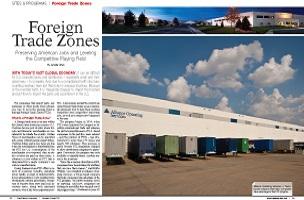
With today’s vast global economy, it can be difficult for U.S. manufacturers and distributors – especially small and mid-sized ones – to compete. And, due to a complicated tariff structure, countless workers have lost their jobs to overseas locations. Because of the inverted tariff, it is frequently cheaper to import the finished product than to import the parts and assemble it in the U.S.
For companies that import parts, raw materials or other goods from abroad, one way to level the playing field is through Foreign Trade Zones (FTZs).
What is a Foreign Trade Zone?
A foreign trade zone is an area within the United States located in or near a U.S. Customs Service port of entry where foreign and domestic merchandise is considered to be outside the country. Certain types of merchandise can be imported into a zone without paying import duties. Customs duties and excise taxes are due when the merchandise is transferred from the FTZ for U.S. consumption. If the merchandise is re-exported, then no duties or taxes are paid on those items. A subzone is a site within an FTZ that is designated for a single company’s use such as manufacturing.
Doing business in an FTZ offers a variety of economic benefits, including lower tariffs, exempt or deferred duty, lower administrative costs resulting from streamlined customs procedures, exemption of exports from state and local inventory taxes, along with increased security, which has been important post-9/11. And, regions around the country are using foreign trade zones as an economic development tool to help their existing businesses stay competitive and retain jobs, as well as to attract new businesses to the area.
The program began in 1934, when FTZs were legislated by Congress to facilitate international trade and enhance the global competitiveness of US-based companies. In the past five years, interest – and the number of FTZs – has skyrocketed to more than 275 zones and nearly 550 subzones.
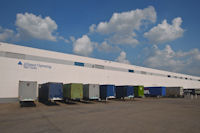 |
| Alliance Operating Services, a Texas-based company that helps companies take advantage of the FTZ program. |
This increase is partly because FTZ regulations changed to allow distribution companies to participate. Previously, the program was only available to manufacturers. Another reason is the economy.
“Since the economic downturn in 2008, companies have been looking for anything that can save them money,” said Kathy Wilkins, vice president at Alliance Operating Services, a Texas-based company that helps companies take advantage of the FTZ program. “In a down economy, you’ll do anything. And now, companies are looking for any dollar they can pull out of their supply chain.”
Enabling businesses to stay more competitive through cost savings
FTZs are probably best known for simplifying and reducing tariffs. One way they do this is by allowing companies to pay for an entire unit, instead of the raw materials imported.
Marge Burton Bevers, FTZ administrator for FTZ 176 at the Greater Rockford Airport Authority in Illinois explained.
“If you’re a major importer who brings in 100 full containers a week, without an FTZ, you might pay tariffs up to $485 per container, in addition to other fees for things like merchandise processing. If you add it up, it’s a big yearly cost,” she said. “But by utilizing a FTZ, the importer will pay only $485 per week for the entire shipment, as opposed to $485 per container. This line item, called ‘weekly entry’ can save the importer more than $1 million per year. That’s huge.”
For companies that re-export products, FTZs save them money by lowering the tariffs and eliminating the time-consuming duty drawback program that eventually refunds some of the tariffs owed to them.
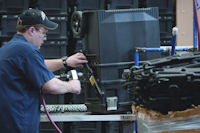 |
| RCTENN’s facility in Gallatin, Tennessee’s FTZ 78. |
RCTENN is a Gallatin, Tennessee, plastic-parts manufacturer that is planning to take advantage of Gallatin’s newly received FTZ designation. On June 30th, 2011, Gallatin, along with a few other areas in Tennessee, received a general purpose expansion of Nashville’s FTZ 78.
RCTENN president, Rob Coleman, currently imports about $3 million in components from overseas. Because the company exports about one third of those components, Coleman can receive a refund on the tariff for those goods through duty drawback, which can take up to 18 months to receive.
“With the FTZ, we’ll pay a lower duty on a number of items and it’ll cost us less to import items that we turn right back around and export. And not to mention, we don’t have to wait to get our money back. It should definitely increase our overseas shipments,” said Coleman.
Fairn & Swanson is another company that benefits from FTZs. The company supplies goods to foreign-flagged vessels, such as cruise lines, and has been operating in foreign trade zones for more than 40 years. Because of rapid growth, it outgrew its old 30,000-square-foot warehouse in the Ft. Lauderdale, Florida, area and moved to a 66,000-square-foot space in the city’s FTZ Site 241.
“The FTZ saved them saving tens of thousands of dollars a month in costly operating fees over their previous location,” said Clara Bennett, airport
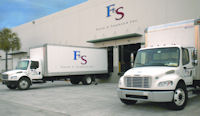 |
| Fairn & Swanson’s facility in Ft. Lauderdale, Florida’s FTZ 241. |
manager at the Ft. Lauderdale Executive Airport that oversees the city’s foreign trade zone.
Fairn & Swanson CEO Achim Fritzen added, “Without a FTZ, doing business would be very cumbersome. It’s absolutely central to the way we operate.”
A tool to preserve jobs and simplify business operations
Both economic development agencies and individual companies are using FTZs to preserve jobs in their areas.
In northern Mississippi’s Lee County, officials lobbied to join the existing FTZ 158 in Warren County. In 2005, that FTZ was amended to include much of the north central part of the state, including Lee County.
“Our goal was to help our upholstered furniture industry,” said Shane Homan, senior VP of economic development services at the Community Development Foundation which serves Tupelo and Lee County. “These companies were in danger of being forced to outsource their sew workers overseas, because of the inverted tariff on upholstery. The precut-and-sew imported from China was taxed at zero percent duty rate, while roll fabrics, which supported cutting and sewing jobs here in the U.S., was taxed at 17 percent.”
Homan and the Community Development Foundation helped several furniture manufacturers take advantage of the FTZ. It preserved 950 cut-and-sew jobs at four companies – and boasts that these companies have added additional workers in this area.
“It absolutely saved jobs in our marketplace,” said Homan.
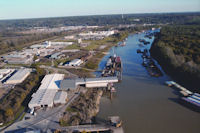 |
| An aerial view of the Port of Vicksburg, a designated FTZ in Warren County, Mississippi. |
The area’s large FTZ is benefitting others as well.
“Our FTZ ranked in the top 10 among all states in the category of receipts, export and employment in 2009, which is significant when you consider Mississippi’s population is only three million,” said Wayne Mansfield, executive director of the Vicksburg-Warren County Economic Development Foundation.
M-I SWACO, A Schlumberger Company, is another example of a company that is using FTZ to both enhance operations and retain U.S. jobs.
For M-I SWACO, A Schlumberger Company, barite is an essential part of the drilling fluids it uses in deep sea drilling in areas like the Gulf of Mexico. Because China is home to 80 percent of the world’s deposits of barite, the company needs to import the mineral. However, the inverted U.S. tariff lets pre-crushed barite enter the country duty free, while it charges $1.25 per metric ton for crude, whole-rock barite. The company brings in the mineral on the huge post-Panamax carriers that hold 70,000 metric tons, meaning that each cargo-load would cost $87,500, in addition to other fees.
If the company were to import ground barite, not only would its Gulf coast grinding mills suffer, the company would face logistical difficulties extracting the tons of powdered rock from the ships.
“Our grinding mills in Amelia and Galveston, Texas, are designated in the Port of South Louisiana’s FTZ 124,” said John McPeak, senior trade compliance manager there. “We bring the crude ore in under special permission and grind it before it enters the commerce of the U.S. Then, we withdraw it and enter it into the U.S. as ground barite. The FTZ is the perfect solution, saving money and preserving jobs.”
Improved inventory control, customs compliance, security and inventory tax exemption
Foreign trade zones help a company’s bottom line in other ways.
Dallas Cowboys Merchandising LTD partnered with Alliance Operating Services when it moved into a 400,000-square-foot FTZ facility in March 2010.
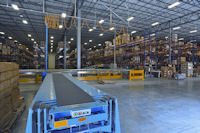 |
| Dallas Cowboys’ merchandise receiving area inside an FTZ. |
Since then, the organization has seen numerous benefits, such as gaining a significant savings from the inventory tax exemption.
“We’ve seen tremendous improvement in supply chain management. It gives us complete visibility, allowing us to have better control of the end to end process,” said Rob Schrimsher, controller of the Dallas Cowboys. “It’s helped us implement an accurate checks and balances, which improves the integrity of the numbers we report. And, the FTZ lockdown has improved security as well as the safeguarding of our inventory and assets.”
John McPeak at M-I SWACO, A Schlumberger Company, concurs. “FTZs are acknowledged as very good security practice, which is important, because in the post-9/11 world, security is a prime focus of U.S. customs.”
Other companies are strategically using FTZs to help their clients maximize sales.
Anderson Packaging in Rockford, Illinois, is a 3rd party contract packager that specializes in pharmaceutical packaging. By having a FTZ subzone established at its facility through Rockford’s FTZ 176, it can import products that aren’t FDA approved to put them into packaging. Sometimes, it ships the finished product to Europe where the drug is approved. But in other instances, it holds onto the product at its facility until the day the drug receives FDA approval.
“That day, we can put the drug on a truck and put it into the U.S. market,” said Chad Spotz, warehouse manager of the pharmaceutical division at Anderson Packaging. “Pharmaceuticals estimate that every single day that a drug has FDA approval but isn’t on the market, they will lose one million dollars.”
FTZs also help importers ensure that their goods are compliant with customs regulations.
The Farrow Group has managed the day to day operations of Battle Creek, Michigan’s general purpose zone FTZ 43 since 1985. The company uses the FTZ to help scores importers save on tariffs as well as stay in compliance with customs.
“For example, we might have a customer with marking issues for their goods. Their goods have shipped and ready to enter into commerce in the U.S. when they realize that the goods aren’t properly marked with the country of origin,” said Dustin King, vice president there. “We can move the goods into our FTZ facility without entering the commerce of the U.S., mark the items with the proper country of origin and then release the goods without the client getting dinged by customs. There are many benefits to utilizing a FTZ that not all importers know.”
A sound economic development tool
Throughout the country, regions are adding FTZs to their arsenal of economic development tools.
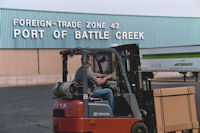 |
| Foreign Trade Zone 43 in Battle Creek, Michigan. |
In Battle Creek, Michigan, Jan Frantz, executive director and licensed U.S. Customs Broker at the Port of Battle Creek FTZ 43, said that the area first pursued FTZ status in the 1970s to combat an unemployment rate of 17 percent. It was able to attract foreign subsidiaries that produced items such as auto parts, shipbuilding assemblies and off-road vehicle components.
“Today, the foreign subsidiaries employ about 8,000 people with an estimated $2.5 billion in investment over the past three-and-a-half decades. Despite the national economic downturn and its grim effects in Michigan, investment in our industrial park thrives,” said Frantz.
Clay Walker, executive director of the Gallatin Area Economic Development Agency, was one of the driving forces behind the area’s incorporation into Nashville’s FTZ.
“Our FTZ is a way to offer an incentive to companies in our area – and is the proper way to do economic development. It can have a significant impact to site selection for new businesses and can potentially help three of our existing companies. It was an easy sell for our leadership to get behind this,” he said.
In fact, companies are jumping at the chance to take part in FTZs. In Rockford, FTZ administrator Marge Burton Bevers is working with Materials Management Solutions, a 3rd party logistics facility that is planning on coming to the area to support Chrysler.
“We thought we’d come to the area for a smaller project with Chrysler and expand our business in the area later on. Within 24 hours of landing in Rockford, our business projections grew substantially, thanks to referrals by Bevers. We’ve received a great reception with many clients hungry for this type of service,” said Barry Griesinger, president of Materials Management Solutions.
David Slater, executive director of the Houma-Terrebonne (Louisiana) Airport Commission helped the area receive FTZ 279 in July 2011. In order for the
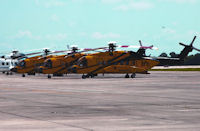 |
| Because of its central location to the Gulf of Mexico, The Houma-Terrebonne Airport logs the greatest number of ultra deep- and deep water flights to oil and gas facilities in the Gulf. |
area’s airport to be part of the FTZ, Slater had to first lobby Louisiana’s legislators to change Louisiana law that previously did not allow airports to apply for FTZ designation.
“We wanted the FTZ for the positive impact it will have on the area,” said Slater. “It will be a cost savings to existing companies as well as a way to incent other companies to locate here. We’ve already been contacted by one company interested in locating here and taking part in the zone.”
Alternate Site Framework makes it even easier for businesses to reap the benefits
A new program called Alternate Site Framework (ASF) makes it easier and faster for companies to take advantage of a foreign trade zone. According to Rockford’s Bevers, it can take a company nine to 18 months and cost $15,000 to $50,000 to become established as an FTZ subzone. However, if the general purpose zone takes part in ASF, it reduces the time to approximately three to four months and reduces the cost to $2,500 to $3,500. And FTZ administrators in other zones say that companies can receive activation in as little as 30 days.
Clara Bennett, airport manager at the Ft. Lauderdale Executive Airport said, “Companies sometimes shy away from FTZs because it can be a lengthy, cumbersome process. But the ASF allows us to have an inventory of sites and spaces that are ready to go, so if a company moves in, they can have pre-designated status, greatly reducing the activation time.”
“ASF helps us be more responsive to business and work in concert with the economic development goals,” Bennett added.
Lisa Braud at the Port of South Louisiana added, “The ASF program gives greater flexibility to bring FTZ designation to the small to mid-sized company with a new simplified application process.”
In short, FTZs are a boon to the local economies
FTZs are living up to their promise of making U.S. businesses more competitive.
“Our trade zone is home to giants such as Valero Refinery, Marathon Oil, Motiva, Halliburton Energy Services and Bollinger Shipyards, among others,” said Lisa Braud, foreign trade zone manager at the Port of South Louisiana FTZ 124. “Thanks to the FTZ program, they are all able to compete on a level playing field with companies around the world due to the duty savings realized through this program.”
She then added, “This, in turn, helps the local economies in terms of jobs, creating new ones and retaining the jobs already in place, as well as supporting the local vendors for supplies and services. It makes a large impact.”
Shane Homan at the Community Development Foundation in Tupelo, Mississippi, agrees.
“We have such an integrated global economy. There are very few companies that aren’t buying or selling products internationally. The one constant about federal trade policy is change and the only federal program designed to protect and encourage U.S. manufacturing companies to maintain their value-added production locally is the FTZ program. It’s been a great benefit to us – and to the country,” he said.
Related Agencies
- Port of South Louisiana
- FTZ #124 - Gramercy, Louisiana - Port of South Louisiana
- FTZ #241 - Fort Lauderdale Executive Airport
- Fort Lauderdale Department of Economic Development
- Houma Terrebonne Airport Commission
- Terrebonne Economic Development Authority
- FTZ # 176 - Rockford, IL
- Rockford Area Econ. Dev. Council - Rockford Area Aerospace Network
- Gallatin Economic Development Association
- Battle Creek Unlimited
- Alliance Operating Services
- Warren County Port Commission
- Vicksburg/Warren Economic Development Foundation

